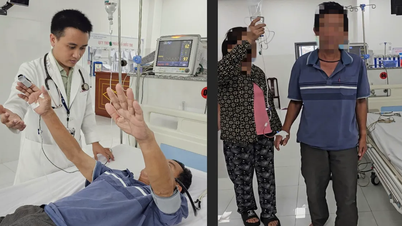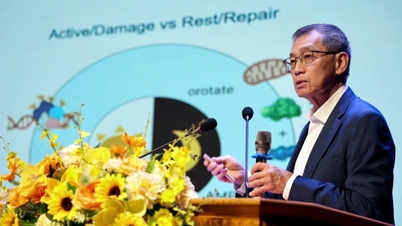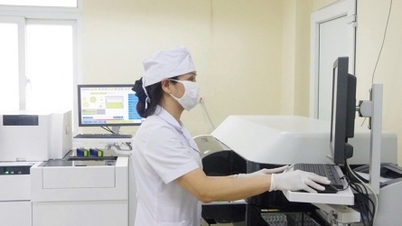This is considered the reason why the couple's first daughter, now 5 years old, has congenital adrenal hyperplasia.
According to Master, Doctor, Specialist I Nguyen Phuong Thao, Center for Fetal Medicine, Tam Anh General Hospital, Ho Chi Minh City, when born, the baby girl had abnormal external genitalia similar to that of a male.
Blood tests showed that the level of 17-hydroxyprogesterone, a steroid hormone produced by the adrenal glands, was more than three times higher than normal, indicating that the baby had adrenal hyperplasia.
Pre-pregnancy and prenatal genetic screening plays an important role in detecting healthy carriers of disease genes and preventing children from having children with serious genetic diseases. |
This disease occurs due to a disorder of adrenal hormone synthesis, causing acute adrenal insufficiency and abnormalities in the external genitalia. Although the baby has a 46 XX chromosome set, meaning female, the external genitalia are masculinized with an enlarged clitoris. The baby has undergone plastic surgery combined with endocrine treatment to improve this condition.
Congenital adrenal hyperplasia is a recessive genetic disease on chromosome 6. Through genetic analysis, the doctor discovered that both Mr. and Mrs. H. carry the CYP21A2 gene mutation and are asymptomatic carriers. Because they were not screened before pregnancy, the disease gene was passed on to their daughter.
If detected early in pregnancy, the baby can be treated in the womb, helping to avoid masculinization of the external genitalia. At the same time, after birth, the baby can be treated with hormones to limit dangerous complications such as dehydration that can cause death.
Genetically, when both husband and wife carry the recessive gene that causes the disease, the second child has a 25% chance of being born healthy, a 25% risk of having congenital adrenal hyperplasia with levels ranging from mild to severe, and a 50% chance that the child will be a healthy carrier of the disease gene, which can be passed on to the next generation.
After undergoing genetic screening before pregnancy, Ha and her husband chose in vitro fertilization combined with embryo screening to ensure the birth of a healthy baby.
Genetic screening to identify healthy carriers of the disease gene helps prevent and minimize the condition of masculinization of the external genitalia in girls. Prenatal genetic testing also helps doctors plan timely treatment when the child is born, preventing acute adrenal insufficiency.
If masculinized girls are treated early, they can develop normally; on the contrary, late diagnosis can lead to complete masculinization, causing infertility and sterility later on.
Boys with the disease often experience early puberty and stunted growth. Patients require lifelong hormone replacement therapy and surgical correction of external genital malformations.
Congenital adrenal hyperplasia has an incidence of about 1/10,000 to 1/15,000 live births. The disease can cause serious symptoms such as hyperkalemia, vomiting, dehydration, poor weight gain, low blood pressure, hypoglycemia, electrolyte disturbances, circulatory shock and risk of death if not treated promptly.
The disease also leads to abnormal development of the genitals, such as clitoral hypertrophy in girls, large penis or small testicles in boys, and pubertal and menstrual disorders.
Patients are also at risk of developing cardiometabolic diseases such as hypertension, obesity, dyslipidemia, insulin resistance and glucose imbalance. However, if detected and treated early, the babies can have a near normal life and still have the ability to give birth to healthy children.
Pre-pregnancy and prenatal genetic screening plays an important role in detecting healthy carriers of disease genes and preventing children from having children with serious genetic diseases.
With the development of fetal medicine and modern genetic technology, many dangerous diseases can be effectively controlled if detected early, providing opportunities for development and a normal life for children and their families.
In addition to the above pathology, Thalassemia is a genetic disease characterized by a decrease or deficiency in the synthesis of globin chains in the hemoglobin molecule, an important component of red blood cells. The disease includes two main forms: α-Thalassemia and β-Thalassemia, depending on the affected globin chain.
Gene mutations that cause globin deficiencies can lead to severe forms of the disease, causing severe anemia, affecting the health and development of children.
According to Dr. Luyen Thi Thanh Nga, Medlatec Genetic Center, the rate of people carrying the Thalassemia gene in Vietnam is quite high, about 13.8% of all ethnic groups.
In particular, some ethnic minorities such as Tay, Thai, Muong have a rate of carrying the α-Thalassemia gene up to over 20%. At Medlatec, in 2025, the SEA mutation is the most common form in cases of detected α-Thalassemia.
Thalassemia is a recessive genetic disease, so people carrying the gene often do not show any external symptoms, making it difficult to detect without specialized testing. If both husband and wife carry the Thalassemia gene, the risk of having a child with a severe form of the disease can be up to 25%.
Therefore, prenatal or pre-marital genetic screening is essential for counseling and prevention. In the case of Ms. K. and her husband, the doctor specifically advised on the risk of giving birth to a child with severe Thalassemia, and performed amniocentesis for prenatal diagnosis. The results showed that the fetus had a normal genotype, helping the family feel secure in continuing the pregnancy.
Doctors also recommend that in subsequent pregnancies, couples can choose natural pregnancy combined with amniocentesis for prenatal diagnosis or in vitro fertilization combined with embryo screening to minimize risks.
Severe thalassemia causes chronic anemia, requiring lifelong blood transfusions, and can easily lead to bone deformities, enlarged liver and spleen, heart failure, and possibly early death if not treated promptly. The disease also creates a huge mental and financial burden for families and society.
Therefore, Thalassemia gene screening not only helps to detect individuals carrying the disease gene early but also helps couples plan to have children safely, minimizing the risk of the disease for future generations. This is an effective preventive measure and needs to be widely disseminated in the community.
Source: https://baodautu.vn/sang-loc-truoc-sinh-giup-ngan-ngua-hieu-qua-di-tat-cho-tre-d331979.html







![[Photo] 60th Anniversary of the Founding of the Vietnam Association of Photographic Artists](/_next/image?url=https%3A%2F%2Fvphoto.vietnam.vn%2Fthumb%2F1200x675%2Fvietnam%2Fresource%2FIMAGE%2F2025%2F12%2F05%2F1764935864512_a1-bnd-0841-9740-jpg.webp&w=3840&q=75)
![[Photo] National Assembly Chairman Tran Thanh Man attends the VinFuture 2025 Award Ceremony](/_next/image?url=https%3A%2F%2Fvphoto.vietnam.vn%2Fthumb%2F1200x675%2Fvietnam%2Fresource%2FIMAGE%2F2025%2F12%2F05%2F1764951162416_2628509768338816493-6995-jpg.webp&w=3840&q=75)










































































































Comment (0)